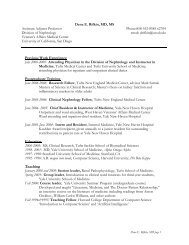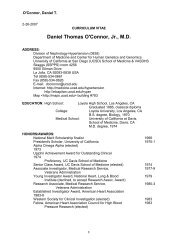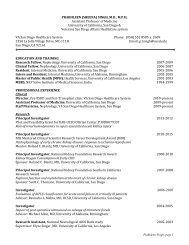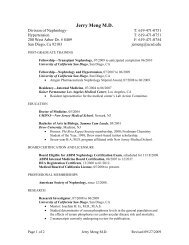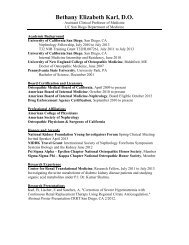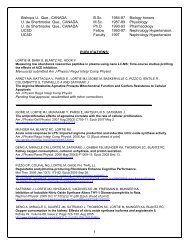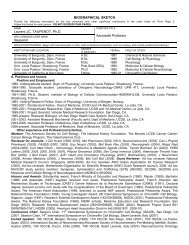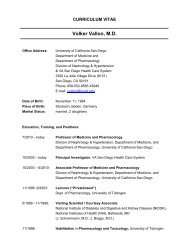Satish P. RamachandraRao, M.Sc., Ph.D. - Division of Nephrology ...
Satish P. RamachandraRao, M.Sc., Ph.D. - Division of Nephrology ...
Satish P. RamachandraRao, M.Sc., Ph.D. - Division of Nephrology ...
Create successful ePaper yourself
Turn your PDF publications into a flip-book with our unique Google optimized e-Paper software.
<strong>Satish</strong> P. <strong>RamachandraRao</strong>, M.<strong>Sc</strong>., <strong>Ph</strong>.D.<br />
Assistant Pr<strong>of</strong>essor <strong>of</strong> Medicine,<br />
Director, Biomarkers Laboratory,<br />
Co-Director, Bioanalytical Core, O’Brien Center for Acute Kidney Injury Research,<br />
Divn. <strong>Nephrology</strong> – Hypertension, <strong>Sc</strong>hool <strong>of</strong> Medicine<br />
Center for Promotion <strong>of</strong> Maternal Health and Infant Development,<br />
Divn. <strong>of</strong> Dysmorphology & Teratology,<br />
UC San Diego Dept. <strong>of</strong> Pediatrics,<br />
Clinical Teaching Facility Bldg C; Ste 205B<br />
214 Dickinson St Mail Box 8324 San Diego, CA 92103.<br />
619-543-7298 (Pref. Work & Direct) 619-471-0407 (Lab)<br />
619-543-7769 (Fax) satishrao@ucsd.edu (email)<br />
http://nephrology.ucsd.edu/faculty/pr<strong>of</strong>iles/<strong>RamachandraRao</strong>.shtml<br />
OBJECTIVES<br />
To lead and conduct translational biomedical research aimed at<br />
understanding different stages <strong>of</strong> disease physiology - manifestation,<br />
progression and regression, using biomarkers developed by proteomic,<br />
metabolomic and other biochemical methods.<br />
EDUCATION<br />
2004 Thomas Jefferson University; <strong>Ph</strong>iladelphia, Pennsylvania.<br />
Post-Doctoral Fellowship, Biomarkers in Diabetic Nephropathy.<br />
2002 Indian Institute <strong>of</strong> <strong>Sc</strong>ience; Molecular Biophysics Unit, Bangalore, India<br />
Post-Doctoral Fellowship.<br />
1999 Christian Medical College Hospital, Vellore, India.<br />
Dissertation: “Protein <strong>Ph</strong>osphorylation in Human & Monkey Cerebellum<br />
and the Neurotransmitter Receptor Triad from the Monkey Brain.”<br />
Advisor: Ailam S. Balasubramanian, <strong>Ph</strong>.D.<br />
1993 Bangalore University; Bangalore, India.<br />
Master <strong>of</strong> <strong>Sc</strong>ience (Specialization: Biochemistry)<br />
1991 Bachelor or <strong>Sc</strong>ience (Triple Major: Chemistry, Botany, Zoology)<br />
EXPERIENCE<br />
2012-till date<br />
Director; Biomarkers Laboratory,<br />
Co-Director, Bioanalytical Core, O’Brien Center for AKI Research<br />
UC San Diego<br />
My activities at the NIH-funded O’Brien Center are:<br />
• To develop and direct application <strong>of</strong> AKI research tools<br />
• To provide cutting edge research expertise to investigators within and outside UCSD<br />
involved in clinical and translational research in AKI<br />
• To impart education and training to young researchers in Translational Research in AKI<br />
in various etiologies<br />
Page 1 <strong>of</strong> 17
2007-till date Assistant Pr<strong>of</strong>essor <strong>of</strong> Medicine; Department <strong>of</strong> Medicine, <strong>Division</strong> <strong>of</strong><br />
<strong>Nephrology</strong>-Hypertension, University <strong>of</strong> California, San Diego.<br />
My role as a faculty <strong>of</strong> the school <strong>of</strong> Medicine at UC San Diego is tripartite: a) Research<br />
<strong>Sc</strong>holarship, b) Teaching and c) University Services.<br />
a. Research <strong>Sc</strong>holarship<br />
• Development <strong>of</strong> Translational Research Focused on Exosomes<br />
o Exosome purification technology development: led the interdisciplinary<br />
group comprising <strong>Nephrology</strong>–Biochemical Genetics divisions that<br />
successfully invented a s<strong>of</strong>t method to isolate and purify exosomes from<br />
any given bio-fluid source.<br />
o Demonstrated that the non-invasively obtained human urinary exosomes<br />
that were isolated and purified using the above methodology could be used<br />
as an excellent source <strong>of</strong> biomarkers tracking the physiologic status <strong>of</strong> the<br />
cell/organ that the exosomes were derived from. As a result, urine<br />
biomarker changes accompanying disease states have been characterized<br />
with specific reference to progression <strong>of</strong> pregnancy in diabetic background<br />
(Type-2 diabetic pregnancy) and progression <strong>of</strong> diabetes in the pregnancy<br />
background (gestational diabetes). Technology extendable to study any<br />
given disease biology<br />
• Development <strong>of</strong> Translational Research Focused on Proteomics<br />
o Developed Proteomics and Metabolomics discovery platforms to<br />
understand selective pathway enrichment phenomena in general health,<br />
and how they get altered in disease.<br />
o Systems Biology (SB) approach to not only tease out meaningful data<br />
from proteomics/Metabolomics platforms, but also understand how<br />
different pathways are affected in diabetic kidney disease. Primary and<br />
corresponding author on original research proteomics articles published in<br />
prestigious Journal <strong>of</strong> American Society <strong>of</strong> <strong>Nephrology</strong> (JASN) and<br />
Expert Reviews in Endocrinology and Metabolism (EREM).<br />
o The diabetic kidney proteomics/SB abstract we submitted to the 9th<br />
International Human Proteome Organization (HUPO) meeting held in<br />
Toronto, Canada (2009), was selected for oral presentation in the very<br />
prestigious HKUPP (Human Kidney and Urine Proteomics Project)<br />
workshop that was held as part <strong>of</strong> the 9th HUPO meeting. My talk was<br />
(the only talk selected from USA) one among the only 7 oral presentations<br />
selected for presentation in this workshop that featured cutting edge<br />
research applications addressing pathophysiology <strong>of</strong> kidney disease.<br />
• Development <strong>of</strong> Translational Research Focused on Urinary Biomarkers<br />
o Demonstrated the effect <strong>of</strong> HIV (human immunodeficiency virus)<br />
infection on biology <strong>of</strong> THP (Tamm-Horsfall Protein), the most abundant<br />
protein in the healthy human urine synthesized exclusively in the renal<br />
tubules.<br />
o Demonstrated that the Leptospirosis infection results in different host<br />
responses in male and female infected rats. Neutral amino peptidase sorts<br />
into urine exosomes in the rat kidney tubules in response to leptospirosis<br />
infection.<br />
Page 2 <strong>of</strong> 17
. Teaching: I have been involved in both within and outside the classroom teaching:<br />
• Regular Classroom Teaching<br />
SPPS 240 Histology course at the Skaggs <strong>Sc</strong>hool <strong>of</strong> <strong>Ph</strong>armacy and<br />
<strong>Ph</strong>armaceutical <strong>Sc</strong>iences, UC San Diego. My teaching is well-received<br />
(Continuously rated 4.3/5.0 from 2008 - 2013) by students <strong>of</strong> <strong>Ph</strong>armacy.<br />
• On Bench Translational Laboratory Research Training<br />
• One <strong>of</strong> my teaching foci has been the under-represented/under-privileged<br />
minority section. I helped an under-privileged minority section undergraduate<br />
research fellow to obtain a research scholarship from Amgen to work during<br />
the summer <strong>of</strong> 2008 in my laboratory. This student then went on to attend the<br />
2008 national meeting for the Society for Advancement <strong>of</strong> Chicanos and<br />
Native Americans in <strong>Sc</strong>ience (SACNAS) conference held in Salt Lake City<br />
Utah (October 9-12, 2008). The poster exhibited by this student not only got<br />
selected for oral presentation, but also won the best presentation award. Thus<br />
my commitment to encourage the students continually to raise the bar and aim<br />
at extraordinary achievement has been recognized outside the UC San Diego<br />
community as well.<br />
• I have been involved in teaching outside the classroom in various capacities in<br />
the last few years. The topics <strong>of</strong> teaching ranged from bench work to the<br />
undergraduate researchers, to the specifics <strong>of</strong> podocyte culture with<br />
collaborators, and 2d gel electrophoretic technique. I ran podocyte work shops<br />
that was attended by post-doctoral fellows and faculty alike.<br />
c. My University Services include: Peer Review, Public Service, Extracurricular and Other<br />
Activities, as follows:<br />
• University Service 1: Peer Research Reviewing for Journals: I have been a<br />
peer reviewer <strong>of</strong> research articles submitted for publication to Journals listed<br />
below:<br />
• American Journal <strong>of</strong> <strong>Ph</strong>ysiology Renal <strong>Ph</strong>ysiology (2007-till date)<br />
• Translational Research (2008-till date)<br />
• <strong>Ph</strong>armacology, Experimental Biology & Medicine (2008-till date).<br />
• The Application <strong>of</strong> Clinical Genetics (2009-till date).<br />
• The Journal <strong>of</strong> Diabetes and Its Complications (2010-till date).<br />
• Lab Investigation (2010-till date).<br />
• Journal <strong>of</strong> Endocrinology (2013-till date)<br />
• University Service 2: Public Service<br />
• Chairman, Biomedical Library Advisory Committee (BLAC), UC San<br />
Diego I served as the chairman <strong>of</strong> the BLAC for two terms between 2011-12<br />
and 2012-13.<br />
• Member <strong>of</strong> the BLAC<br />
I served as a member <strong>of</strong> the BLAC between 2008-9 to 2011-12 for 3 terms. A<br />
member <strong>of</strong> the UC San Diego BLAC is expected to provide advice to librarian<br />
on issues pertaining to library services and policies. Committee members also<br />
serve as liaison between the library and the member group they represent.<br />
Page 3 <strong>of</strong> 17
• Podocyte Culture Related Workshops: To benefit the fellow-researchers I<br />
have conducted podocyte culture workshops, during which I run practical<br />
sessions to show how to carry out the podocyte culture. I do this because,<br />
despite the comprehensive nature <strong>of</strong> the protocol write up, certain nuances that<br />
cannot be captured in print exist. Podocyte culture is a complicated and<br />
cumbersome operation, not a straightforward task. Cultured podocyte is a<br />
critical tool required to address many questions that are being asked and<br />
addressed, regarding the role <strong>of</strong> podocytes in healthy kidney as well as in<br />
kidney disease. Since I have many years <strong>of</strong> experience in podocyte culture,<br />
and have developed expertise and ability to troubleshoot any aspect <strong>of</strong><br />
podocyte culture, I conduct these workshops to explain the scruples <strong>of</strong><br />
culturing these important kidney cells and also give a live demonstration <strong>of</strong><br />
the entire process. <strong>Sc</strong>ientists from both UC San Diego as well as outside<br />
(<strong>Sc</strong>ripps Research Institute) UC San Diego have benefitted from these<br />
workshops, some <strong>of</strong> the individuals that benefited from these workshops<br />
include:<br />
o Dr. Karen Sykes, Marilyn Farquhar Lab, Dept. <strong>of</strong> Cellular and<br />
Molecular Medicine, UC San Diego<br />
o Dr. Kuixing Zhang, <strong>Ph</strong>. D., Post-doctoral Fellow, Dan O’Connor<br />
Lab, <strong>Nephrology</strong> <strong>Division</strong>, <strong>Sc</strong>hool <strong>of</strong> Medicine, UC San Diego<br />
o Dr. Celine DerMardirossian, <strong>Ph</strong>.D., Assistant Pr<strong>of</strong>essor,<br />
Immunology Department, The <strong>Sc</strong>ripps Research Institute<br />
• University Service 3: Extracurricular Activities.<br />
• Participation in relevant international meetings:<br />
o 7th International Podocyte Meeting, Toronto, Canada, June 2008.<br />
o The 2 nd Indo-US workshop on Mitochondrial Research &<br />
Medicine 2008; Life <strong>Sc</strong>iences Center, Manipal University,<br />
Manipal, India<br />
o 9 th International Human Proteome Organization Meeting on<br />
Proteomics; Toronto, Canada. September 2009<br />
o The International Society <strong>of</strong> <strong>Nephrology</strong> (ISN) Nexus Symposium<br />
Geneva, Switzerland, 2010<br />
o 45 th Annual Meeting & <strong>Sc</strong>ientific Exposition <strong>of</strong> the American<br />
Society <strong>of</strong> <strong>Nephrology</strong>, San Diego, November 2012<br />
o 5 th Annual Meeting <strong>of</strong> Proteomics Society – India, Bangalore, Nov<br />
2013.<br />
• Gave a talk entitled “Urinary Exosome Paradigm <strong>of</strong> Kidney<br />
Failure: Clinical Utility <strong>of</strong> Exosome Proteomics”<br />
• Panelist for the discussion entitled “ Application <strong>of</strong> Mass-<br />
Spectrometry in Medical Research”<br />
• Friday noon VA-Neuropathology Journal clubs<br />
• Tuesday afternoon renal grand rounds<br />
Page 4 <strong>of</strong> 17
• University Service 4: Other Academic activities:<br />
• 1: Laboratory Service for collaborators: Serum creatinine estimation by<br />
High Performance Liquid Chromatography:<br />
o I have set up the High Performance Liquid Chromatography<br />
(HPLC) (Perkin Elmer Instruments) method <strong>of</strong> estimating the<br />
Serum Creatinine levels as the surrogate marker <strong>of</strong> Kidney<br />
Glomerular Filtration Rate (GFR) Determination.9 th International<br />
Human Proteome Organization Meeting on Proteomics held in<br />
Toronto, Canada. September 2009<br />
o The HPLC method is capable <strong>of</strong> reliably and quickly measuring<br />
the serum creatinine levels in mouse serum (15 minute run time); It<br />
is robust and sensitive (can measure creatinine at as low as 0.05<br />
mg/dl). This ia a service that I render to collaborators within the<br />
university and outside the university across the country.<br />
o Our group is arguably the best among peers for Serum creatinine<br />
estimation by HPLC, and the results obtained from our HPLC<br />
serum creatinine protocol correlate very well with the pathology <strong>of</strong><br />
various kidney disease conditions known to affect the GFR.<br />
o Earns revenue for the University.<br />
• 2: Helped move the lab from <strong>Ph</strong>iladelphia to San Diego. Set up the lab for<br />
Dr. Kumar Sharma’s research group in room # 410 <strong>of</strong> Stein Clinical Research<br />
Building from scratch, June 21, 2007 onwards.<br />
o Managed the efforts <strong>of</strong> half a dozen personnel to put the lab<br />
equipment in place in Room 410 <strong>of</strong> the Stein Clinical Research<br />
Building.<br />
o Put in due diligence for Dr. Kumar Sharma’s lab to hire new<br />
personnel, an animal technician and a laboratory research scientist.<br />
Led and mentored a team <strong>of</strong> Renal Fellows, Postdocs and<br />
Undergraduates performing Translational Proteomics research on<br />
human urine, animal tissue, cell culture and exosomes to develop<br />
biomarker discovery platforms. <strong>Nephrology</strong>-<strong>Division</strong> and<br />
Department <strong>of</strong> Medicine committee <strong>of</strong> appointments and<br />
promotions identified “engine driving the establishment <strong>of</strong> the<br />
Translational Research Lab at UC San Diego”.<br />
o Actively developed new collaborations for this translational<br />
research lab.<br />
2005 – 2007 Instructor <strong>of</strong> Medicine; Department <strong>of</strong> Medicine, <strong>Division</strong> <strong>of</strong><br />
<strong>Nephrology</strong>, Thomas Jefferson University.<br />
My role as a faculty <strong>of</strong> the school <strong>of</strong> Medicine at Thomas Jefferson University was focused on<br />
Research and Teaching:<br />
• Performed proteomic research both independently and in conjunction with external<br />
collaborators.<br />
• Presented seminars with regard to applications <strong>of</strong> proteomic research to study diabetic<br />
nephropathy.<br />
Page 5 <strong>of</strong> 17
• Provided general proteomics guidelines to biochemical investigators from across<br />
different departments at Jefferson.<br />
• Initiated independent research programs focusing on<br />
o Differential expression <strong>of</strong> peptides and its role in diabetic nephropathy – involving<br />
the fractionation <strong>of</strong> peptides into 3 broad groups, namely 5 – 10 kDa; 3 – 5 kDa and<br />
≤ 3 kDa; and further fractionation <strong>of</strong> comparatively more complex peptide fractions<br />
by Size Exclusion Chromatography and subsequent identification <strong>of</strong> peptides using<br />
nano-spray ESI-LC/MS/MS. The fractionation protocol lead to the following:<br />
o Development <strong>of</strong> a generic method for technically more feasible and cost-effective<br />
storage / retrieval <strong>of</strong> human urinary protein over long duration<br />
o Comparative proteomic studies <strong>of</strong> diabetic nephropathy human urine samples in an<br />
effort to identify biomarkers and disease progression markers for diabetic<br />
nephropathy. These studies employed 2D-electrophoresis including DIGE<br />
technology, Proteome Partitioning & removal <strong>of</strong> 12 most abundant proteins<br />
(immunoaffinity-subtraction proteomics) and protein identification by LC/MS/MS<br />
techniques.<br />
o<br />
Comparative proteomic studies <strong>of</strong> db/db mouse model kidney protein samples before<br />
and after pirfenidone treatment in an effort to identify biomarkers and disease<br />
activity / progression markers for diabetic nephropathy. These studies have so far<br />
employed LC/MS/MS techniques (specifically label-free mass spectral quantitative<br />
methods).<br />
• Mentoring Senior <strong>Nephrology</strong> Fellowship-trainees in proteomic and protein chemical<br />
research techniques.<br />
2002 – 2004 Post-doctoral Fellow; Department <strong>of</strong> Medicine, <strong>Nephrology</strong> <strong>Division</strong>,<br />
Thomas Jefferson University.<br />
• Single-handedly standardized and applied numerous proteomic and related protein<br />
analytical techniques to address biomarker discovery questions in Diabetic Nephropathy<br />
at three levels namely i) human bio-fluid, ii) animal models and iii) renal cell culture.<br />
Cultures in<br />
o 2-dimension – for the analysis <strong>of</strong> total membrane, cell-surface & cytosolic subproteomes<br />
via sub-cellular fractionation<br />
o 3-dimension – encapsulated renal cell studies to mimic the kidney 3D structure<br />
The techniques to study all three model systems generally involved simple protein<br />
purification, protein separation – both chromatographic and electrophoretic: including<br />
differential in-gel (DIGE) analysis, high-throughput robotic processing, mass spectral<br />
analysis <strong>of</strong> proteins and peptides, mass spectral characterization <strong>of</strong> protein posttranslational<br />
modification (e.g. phosphorylation, glycosylation), characterization <strong>of</strong><br />
protein-protein interactions, and independent validation by immun<strong>of</strong>luorescence, western<br />
immunoblotting and ELISA. In addition to the above, renal cell studies featured further<br />
fractionation into cytosol and total membrane sub-proteomes<br />
• Specialized in differential protein expression and biomarker discovery studies comparing<br />
normal and altered biological samples.<br />
o Employed 2D-electrophoresis and multidimensional LC/MS/MS techniques for<br />
these purposes.<br />
Page 6 <strong>of</strong> 17
o Developed a variation <strong>of</strong> the DeCyder s<strong>of</strong>tware for analysis <strong>of</strong> (statistically<br />
significant) up- & down-regulation <strong>of</strong> spots in Sypro-stained 2D-gels featuring<br />
proteins from two different populations (human mesangial cell sub-proteomes in<br />
normal & high glucose)<br />
o Independent follow-up and validation <strong>of</strong> the proteomic data by western<br />
immunoblotting, confocal microscopy and ELISA<br />
• Investigated the growth factor-induced cytoskeletal rearrangements in HUVECs and the<br />
IP 3 R-biology in mesangial cells by biochemical and protein chemical approaches.<br />
• Investigated the role <strong>of</strong> Nox4 protein in mediating stimulation <strong>of</strong> reactive oxygen species<br />
by high glucose in human mesangial cells<br />
• Mentored Senior <strong>Nephrology</strong> Fellowship-trainees in proteomics research techniques<br />
1998 – 2001 Post-doctoral Fellow; Molecular Biophysics Unit, Indian Institute <strong>of</strong><br />
<strong>Sc</strong>ience,Bangalore, India<br />
• Investigated the biophysical aspects <strong>of</strong> the role <strong>of</strong> central linker <strong>of</strong> Calmodulin in target<br />
recognition by Isothermal Titration Calorimetry.<br />
• Studied fatty acid synthase 2 in Plasmodium falciparum, as an anti-malarial<br />
chemotherapeutic target.<br />
• Studied lectin affinity chromatography applications in diagnosis <strong>of</strong> clinical conditions<br />
• Investigated the characterization <strong>of</strong> glycolipid-bearing liposomes as delivery vehicles<br />
1993 – 1997 CSIR-UGC (Govt. <strong>of</strong> India) Research Fellow, Neurochemistry<br />
Laboratory,Christian Medical College Hospital, Vellore, India.<br />
• Investigated monkey cerebellum & spinal cord neurotransmitter receptor phosphorylation<br />
– <strong>Ph</strong>.D thesis,<br />
• Investigated changes in rat brain endogenous protein phosphorylation as a marker for the<br />
different stages in the developing rat brain<br />
• Investigated the zinc- and heparin- binding glycoprotein kinases from human cerebellum<br />
and their endogenous substrates<br />
• Studied phosphorylation as a functional probe <strong>of</strong> a 25 kDa peripheral nerve glycoprotein<br />
(a receptor to Mycobacterium leprae, the leprosy-causing organism) – an original<br />
finding<br />
TECHNICAL SKILLS<br />
• Protein: Purification and Characterization (Structural and Enzymatic –<br />
Immun<strong>of</strong>luorescence-confocal, Western Immunoblotting, Immunohistochemistry and<br />
ELISA), Protein and Peptide Analysis via Mass Spectrometry (MALDI-ToF,<br />
Electrospray-Ion-trap LC/MS, SELDI), Gel Electrophoresis (1-D, 2-D, Isoelectric<br />
Focusing, DIGE), Column Chromatography (HPLC, FPLC, 2-D LC applied in Size<br />
Exclusion, Hydrophobic Interaction, Ion Exchange and Affinity settings), Fluorescent<br />
<strong>Sc</strong>anning and Imaging, High-throughput Robotics, Steady-State and Transient (pre-<br />
Steady-State) Fluorescence Kinetics, Fluorescence and UV/VIS Spectroscopy,<br />
Isothermal Titration Calorimetry and Differential <strong>Sc</strong>anning Calorimetry;<br />
Glycoprotein Structural Characterization & Microheterogeneity Determination via<br />
Page 7 <strong>of</strong> 17
Mass Spectrometry, Differential Lectin Analysis & Serial Lectin Affinity<br />
Chromatography, Protein function analysis by Radio Isotope Pulse Chase & Uptake<br />
physiology in the presence <strong>of</strong> functional inhibitors; Radiation Safety Certified.<br />
• Human Samples (HIPAA-, ERB- Certified); Bi<strong>of</strong>luid analysis: Urine-Serum- & Kidney<br />
Tissue Proteomics; Proteome partitioning: abundant / non-abundant proteins; Tissue<br />
analysis: Cerebellum / Kidney Protein kinases & Receptors; endogenous<br />
phosphorylation<br />
• Animal Handling; Organ-level isolation from Monkey, rat, mouse, cow under<br />
anaesthesia for protein / RNA studies; Glomerular isolation from mouse & rat kidney;<br />
Clinical parameters (blood & urine glucose, TGF β, serum creatinine)<br />
• Molecular and Cellular; genomic DNA and viral RNA purification, Transformation,<br />
PCR/RT-PCR, Cell culture/transfection, In vitro viral propagation, Cloning /<br />
Mutagenesis, Protein expression / purification, BL-3 Lab Certified<br />
HONORS AND AWARDS<br />
2009 NCLAM Awardee – National Center <strong>of</strong> Leadership in Academic<br />
Medicine 2009 class participant.<br />
2001 Research Associateship – Council <strong>of</strong> <strong>Sc</strong>ientific & Industrial Research,<br />
Govt. <strong>of</strong> India, India<br />
1998 Research Associateship – Dept. <strong>of</strong> <strong>Sc</strong>ience & Technology, Govt. <strong>of</strong><br />
India, India<br />
1996 Senior Research Fellowship – Council <strong>of</strong> <strong>Sc</strong>ientific & Industrial<br />
Research, Govt. <strong>of</strong> India, India<br />
1993 Junior Research Fellowship – Council <strong>of</strong> <strong>Sc</strong>ientific & Industrial<br />
Research, Govt. <strong>of</strong> India, India<br />
1993 Lectureship CSIR-University Grants Commission National Joint Entrance<br />
Test, New Delhi, India<br />
1990 6 th Rank National Entrance Examination (M<strong>Sc</strong> Biochem.) Bangalore<br />
Univ., Bangalore, India.<br />
1992 1 st rank (Topper): Fellow <strong>Sc</strong>ientist’s position, CFTRI, Mysore, India<br />
1991 Merit <strong>Sc</strong>holarship Award, 1991-92, Karnataka State Teacher's<br />
Association, Bangalore, India<br />
1985 Merit <strong>Sc</strong>holarship Award, 1984-85, BEL High <strong>Sc</strong>hool, Bangalore, India<br />
for securing highest (Topper) marks in 5 categories viz., Maths, General<br />
<strong>Sc</strong>ience, Social Studies, Grammar & Languages (Kannada & English)<br />
ADDITIONAL TRAINING<br />
• Practical Liquid Chromatography/Mass Spectrometry (LC/MS) Techniques;<br />
American Chemical Society Short courses, NJ 2006. An advanced course covering the<br />
theory and application <strong>of</strong> coupling HPLC and microLC to different versions <strong>of</strong> Mass<br />
Spectrometry.<br />
• Mass Spectrometry <strong>of</strong> Glycoproteins Complex Carbohydrate Research Center, Univ.<br />
<strong>of</strong> Georgia, Athens, Georgia, 2006. An advanced course covering the Structural<br />
Characterization <strong>of</strong> Glycoproteins and Glycopeptides by Mass Spectrometry.<br />
Page 8 <strong>of</strong> 17
PROFESSIONAL ASSOCIATIONS<br />
2007 – present Member, World Human Proteome Organization (HUPO)<br />
2007 – present Member, US Human Proteome Organization (US-HUPO)<br />
2002 – present American Society for <strong>Nephrology</strong>, USA– participating fellow.<br />
2005 – present American Chemical Society, USA– member.<br />
2005 – present American Society for Mass Spectrometry, USA– member.<br />
2005 – present Member <strong>of</strong> The Association <strong>of</strong> Biomolecular Resource Facilities<br />
1993 – 2002 Society for Biological Chemists, India – member.<br />
PUBLICATIONS<br />
1. <strong>Satish</strong> P. <strong>RamachandraRao</strong>, Corrilynn O. Hileman, Chanthel Kokoy-Mondragon,<br />
Jennifer A. Horng, Roni Khoshaba, Anousone Bounkhoun, Danielle Labbato, Robert T.<br />
<strong>Sc</strong>hooley, and Grace A. McComsey Tamm-Horsfall protein levels in HIV infected<br />
subjects associate inversely with levels <strong>of</strong> serum creatinine and soluble tumor<br />
necrosis factor receptor. (Submitted to Journal <strong>of</strong> AIDS, 2014)<br />
2. <strong>Satish</strong> P. <strong>RamachandraRao</strong>, Michael Matthias, Chanthel-Kokoy Mondrogon, Eamon<br />
Aghania, Casey Kong, Michelle Ishaya, Jennifer Horng, Avital Slavin, Roni Khoshaba,<br />
Fabrizio, Antonella De Palma, Anna Maria Agresta, Robert K. Naviaux, Ravi Mehta,<br />
Joseph Vinetz, Priti Talwar and Pierluigi Mauri. Urine Exosome Proteomic Analysis<br />
Reveals Renal Tubule-based Host Response to Leptospirosis Infection in Rats.<br />
(Submitted to PLOS One, 2014)<br />
3. <strong>Satish</strong> P. <strong>RamachandraRao</strong>, Chanthel Kokoy Mondragon, Marcela Zhou, Kumud<br />
Singh and Robert Naviaux. Interleukin-1 Receptor Associated Protein Like-1 activity in<br />
the kidney: Its role and interactions in diabetes. (In Preparation to be submitted to AJP,<br />
2014).<br />
4. T. Morgan, DuPriest E., Johnson J., Choate M., Anderson R., Farmer M., Zhao D.,<br />
Woods L., <strong>RamachandraRao</strong> S. Lindner J., and A. Frias. "Zonal renal blood flow is<br />
mediated by renal histidine decarboxylase expression" (submitted to JCI, 2014).<br />
5. <strong>Satish</strong> P. <strong>RamachandraRao</strong>, Pam R. Taub, Chanthel Kokoy-Mondragon, Roni<br />
Khoshaba, Anousone Bounkhoun, Michelle Ishaya, Eamon Aghania, Avital Slavin,<br />
Assael Madrigal, Erin Higginbotham, Majid Ghassemian, Landon Wilson, Helen Kim,<br />
Stephen Barnes, Ravindra L. Mehta and Robert K. Naviaux. Acute Kidney Injury<br />
Associated Alteration in Mitochondrial Function Revealed by Urine Exosome<br />
Proteomic Studies in Coronary Artery Bypass Surgery Subjects (Submitted to J<br />
Proteomics, 2014)<br />
6. <strong>Satish</strong> P. <strong>RamachandraRao</strong>, Alyssa Hamlin, , Marcela Zhou, Sandy Ramos, Casey<br />
Kong, Rachael Overcash, Chanthel K. Mondrogon, Kelly Kao, Rosanna Overholser,<br />
Jennifer A. Horng, Roni Khoshaba, Anousone Bounkhoun, Edith Esquada, Michael<br />
Donohue, Majid Ghassemian Maryam Tarsa, and Robert K. Naviaux. Differential<br />
protein pr<strong>of</strong>iling <strong>of</strong> urinary exosomes in human pregnancy reveals a role for cellular<br />
danger response elements in diabetes/obesity (Submitted to Am. J Ob Gyn, 2014)<br />
Page 9 <strong>of</strong> 17
7. Bansaghi S, Golenar T, Madesh M, Csordas G, <strong>RamachandraRao</strong> S, Sharma K, Yule<br />
DI, Joseph SK, Hajnoczky G. Is<strong>of</strong>orm-and species-specific control <strong>of</strong> IP3 receptors by<br />
reactive oxygen species. J Biol Chem. 2014 Jan 27. [Epub ahead <strong>of</strong> print] PMID:<br />
24469450<br />
8. Østergaard J, Bjerre M, <strong>RamachandraRao</strong> S, Sharma K, Nyengaard JR, Hansen TK,<br />
Thiel S, and Flyvbjerg A. Mannose-binding lectin in diabetic kidney disease: the impact<br />
<strong>of</strong> mouse genetics in a type 1 diabetes model. Exp Diabetes Res. (2012). 2012: Article ID<br />
678381, 9 pages.<br />
9. Sharma K, Ix JH, Mathew AV, Cho M, Pflueger A, Dunn SR, Francos B, Sharma S,<br />
Falkner B, McGowan TA, Donohue M, Ramachandrarao S, Xu R, Fervenza FC, Kopp<br />
JB. Pirfenidone for Diabetic Nephropathy. J. Am. Soc. Neph. (2011). 22(6):11444-11451<br />
10. Elizabeth Morse, Jana <strong>Sc</strong>hroth, <strong>Sc</strong>hinichi Okada, <strong>Satish</strong> <strong>RamachandraRao</strong>, Volker<br />
Vallon, Kumar Sharma and Robyn Cunard “TRB3 expression is augmented in diabetic<br />
kidneys and podocytes and reduces podocyte MCP-1 expression”. Submitted to Am J<br />
<strong>Ph</strong>ysiol. Renal <strong>Ph</strong>ysiol. (2010) 5, F965-972<br />
11. Gayen, Jiaur R., Zhang, Kuixing., <strong>RamachandraRao</strong>, <strong>Satish</strong> P., Mahata, Manjula.,<br />
Chen, Yuqing., Naviaux, Robert K., Sharma, Kumar., Mahata Sushil K. and O’Connor,<br />
Daniel T. “ Role <strong>of</strong> reactive oxygen species in hyperadrenergic hypertension:<br />
Biochemical, physiological, and pharmacological evidence from targeted ablation <strong>of</strong><br />
the chromogranin A (Chga) gene”. Circulation: Cardiovasc Genet (2010) 3, 414-425<br />
12. Yuexing Yuan, Xiangying Jiao, Wayne Bond Lau, Yajing Wang, Rong Li, Theodore A.<br />
Christopher, Bernard L. Lopez, <strong>Satish</strong> P. <strong>RamachandraRao</strong>, Ling Tao, & Xin-Liang<br />
Ma., “Glycative Inactivation <strong>of</strong> Thioredoxin-1 by Lipopolysaccharide: A Novel<br />
Mechanism <strong>of</strong> Endotoxic Liver Injury”. (2010) Free Radical Biol Med..332-338<br />
13. <strong>RamachandraRao</strong>, S.P., Shaw, M.A., and Sharma, K., “2-d Difference In-Gel<br />
Electrophoresis (2D-DIGE) and Urinary Proteomics,” (2010) an invited review article for<br />
“Renal and Urinary Proteomics: Methods and Protocols,” Wiley-VCH, publisher, V.<br />
Thongboonkerd, editor.<br />
14. <strong>Satish</strong> P <strong>RamachandraRao</strong>, Priti Talwar, Timothy Ravasi, and Kumar Sharma., “Novel<br />
Systems Biology Insights Using Anti-Fibrotic Approaches for Diabetic Kidney Disease,”<br />
(2010) Expert Rev. Endocrinol. Metab. 5(1), 127-135. Pub. by Future <strong>Sc</strong>ience Group,<br />
London, UK.<br />
15. <strong>Satish</strong> P.<strong>RamachandraRao</strong>, Yanqing Zhu, Timothy Ravasi, Tracy A. McGowan, Irene<br />
Toh, Stephen R. Dunn, Shinichi Okada, Michael A. Shaw and Kumar Sharma.,<br />
“Pirfenidone is Renoprotective in Diabetic Kidney Disease” J. Am. Soc. Neph. (2009).<br />
20(8):1765-75<br />
Page 10 <strong>of</strong> 17
16. Kumar Sharma, <strong>Satish</strong> <strong>RamachandraRao</strong>, Gang Qiu, Hitomi Kataoka Usui, Yanqing<br />
Zhu, Stephen R. Dunn, Raogo Ouedraogo, Kelly Hough, Peter McCue, Lawrence Chan,<br />
Bonita Falkner, Barry J. Goldstein., (2008) “Adiponectin regulates albuminuria and<br />
podocyte function in mice” J. Clin. Invest. 118(5): 1645-56<br />
17. <strong>Satish</strong> P. <strong>RamachandraRao</strong>, Richard Wassell, M. Alexander Shaw & Kumar Sharma.<br />
(2007) Expression Pr<strong>of</strong>iling <strong>of</strong> Human Mesangial Cell Sub-Proteomes Reveals a Role for<br />
Calmodulin in Glucose Uptake; Am J <strong>Ph</strong>ysiol. Renal <strong>Ph</strong>ysiol; 292:1182-1189.<br />
18. Ling Tao, Xiangyin Jiao, Erhe Gao, Wayne Lau, Yuexing Yuan, Bernard Lopez,<br />
Theodore Christopher, <strong>Satish</strong> <strong>RamachandraRao</strong>, William Williams, Garry Southan,<br />
Kumar Sharma, Walter Koch, Xin L. Ma, (2006). Nitrative Inactivation <strong>of</strong> Thioredoxin-1<br />
and Its Role in Post-Ischemic Myocardial Apoptosis. Circulation. 114:1395-1402<br />
19. Madesh M, Hawkins BJ, Milovanova T, Bhanumathy CD, Joseph SK, Ramachandrarao<br />
SP, Sharma K, Kurosaki T, Fisher AB. (2005). Selective role for superoxide in InsP3<br />
receptor-mediated mitochondrial dysfunction and endothelial apoptosis. J Cell<br />
Biol.170:1079-1090.<br />
20. Hu T, Ramachandrarao SP, Siva S, Valancius C, Zhu Y, Mahadev K, Toh I, Goldstein<br />
BJ, Woolkalis M, Sharma K. (2005); Reactive oxygen species production via NADPH<br />
oxidase mediates TGF-β-induced cytoskeletal alterations in endothelial cells. Am J<br />
<strong>Ph</strong>ysiol Renal <strong>Ph</strong>ysiol; 289:F816-F825.<br />
21. Sharma K, Lee S, Han S, Lee S, Francos B, McCue P, Wassell R, Shaw MA,<br />
<strong>RamachandraRao</strong> SP. (2005). Two-dimensional fluorescence difference gel<br />
electrophoresis analysis <strong>of</strong> the urine proteome in human diabetic nephropathy.<br />
Proteomics. 5, 2648-2655.<br />
22. <strong>Satish</strong> P. <strong>RamachandraRao</strong>, Avadhesha Surolia, Namita Surolia (2003) "Triclosan: A<br />
Shot in the Arm for Antimalarial Chemotherapy": Molecular and Cellular Biochemistry<br />
253: 55–63.<br />
23. Posettihalli R. <strong>Satish</strong> & A.Surolia (2003). Sugars as Affinity Ligands: Chapter for the book<br />
entitled “Methods for Affinity Based Separations <strong>of</strong> Enzymes & Proteins” in the series<br />
Methods & Tools in Biosciences and Medicine. pp 115-128 Ed. M.N.Gupta.<br />
24. Surolia N, <strong>Satish</strong> P. <strong>RamachandraRao</strong>, Surolia A. (2002) Paradigm shifts in malaria<br />
parasite biochemistry and anti-malarial chemotherapy. Bioessays. 24,192-196.<br />
25. <strong>Satish</strong> P.R., Surolia A. (2002) Preparation and characterization <strong>of</strong> glycolipid-bearing<br />
multilamellar and unilamellar liposomes. Methods Mol Biol. 199, 193-202.<br />
26. <strong>Satish</strong> P.R., Surolia A. (2001) Exploiting lectin affinity chromatography in clinical<br />
diagnosis. J Biochem Biophys Methods. 49, 625-640.<br />
Page 11 <strong>of</strong> 17
27. Anu K.Moorthy, B.Gopal, P.R.<strong>Satish</strong>, Sudha Bhattacharya, Alok Bhattacharya,<br />
M.R.N.Murthy, A.Surolia. (1999) Thermodynamics <strong>of</strong> target peptide recognition by<br />
calmodulin and a calmodulin analogue: Implications for the role <strong>of</strong> the central linker. FEBS<br />
Lett. 461 19-24.<br />
28. Suneetha, L.M., <strong>Satish</strong>, P.R., Korula, R.J., Suneetha, S.K., Job, C.K. and Balasubramanian,<br />
A.S. (1998) Mycobacterium leprae binds to a 25 -kDa phosphorylated glycoprotein <strong>of</strong><br />
human peripheral nerve. Neurochem. Res. 23, 909-913.<br />
29. Lavanya M. Suneetha, Posettihalli R. <strong>Satish</strong>, Sujai Suneetha, Charles K. Job and Aiylam S.<br />
Balasubramanian. (1997) Mycobacterium leprae binds to a 28-30 – kDa phosphorylated<br />
glycoprotein <strong>of</strong> rat peripheral nerve. Int. J. Leprosy 65, 352-356.<br />
30. <strong>Satish</strong> P.R.and Balasubramanian, A.S. (1995) The neurotransmitter receptor triad: nicotinic<br />
acetylcholine receptor, gamma-aminobutyric acid receptor (type A) and inhibitory glycine<br />
receptor. Curr. <strong>Sc</strong>i. 69, 336-342.<br />
INVITED SCIENTIFIC PRESENTATIONS<br />
1. <strong>Satish</strong> P. <strong>RamachandraRao</strong>. 4 th HKUPP workshop in HUPO2009 Annual Congress<br />
The Westin Harbour Castle, Tornto, Canada September 26, 2009; Invited Talk on<br />
“Proteomics to Interactomics: a streamlined approach to identify high-yield hits”<br />
2. <strong>Satish</strong> P. <strong>RamachandraRao</strong>. National Center for Leadership in Academic Medicine<br />
(NCLAM) 2009 graduation ceremony presentation, University <strong>of</strong> California, San Diego,<br />
September 11, 2009; Talk delivered on “Mitochondria and DNA methylation in<br />
Kidney Development”<br />
3. <strong>Satish</strong> P. <strong>RamachandraRao</strong>. <strong>Nephrology</strong> <strong>Division</strong> Translational Medicine Research<br />
Seminar Series, University <strong>of</strong> California, San Diego, March 18, 2009; Talk delivered<br />
on “Podocyte Regeneration / recruitment”<br />
4. <strong>Satish</strong> P. <strong>RamachandraRao</strong>. Juvenile Diabetes Research Foundation Site Visit talk held<br />
at The <strong>Sc</strong>ripps Research Institute, San Diego, February 18, 2009; Talk delivered on<br />
“Mitochondrial DNA and exosomal biomarkers <strong>of</strong> Diabetic Nephropathy”<br />
5. <strong>Satish</strong> P. <strong>RamachandraRao</strong>. Department <strong>of</strong> Pathology, University <strong>of</strong> California, San<br />
Diego, February 6, 2009; Talk delivered on “Podocyte Injury in the context <strong>of</strong><br />
Myosin 1e Disruption”<br />
6. <strong>Satish</strong> P. <strong>RamachandraRao</strong>. 2 nd Indo-US meeting on Mitochondrial Research and<br />
Medicine, sponsored by Indo-US <strong>Sc</strong>ience & Technology Forum, held at the Manipal Life<br />
<strong>Sc</strong>iences Center, Manipal University, Manipal, India November 12-14, 2008; Invited<br />
talk entitled “Mitochondrial DNA is reduced in the exosomes derived from podocytes<br />
in the presence <strong>of</strong> high glucose and TGF-β.”<br />
Page 12 <strong>of</strong> 17
7. <strong>Satish</strong> P. <strong>RamachandraRao</strong>. Department <strong>of</strong> <strong>Nephrology</strong>, JSS Medical College &<br />
Hospital, Mysore, India August 19, 2008; Invited talk on “Proteomics:Uses and<br />
Limitations in Biomarker Discovery”<br />
8. <strong>Satish</strong> P. <strong>RamachandraRao</strong>. Department <strong>of</strong> <strong>Nephrology</strong>, Christian Medical College &<br />
Hospital, Vellore, India, August 12, 2008; Invited talk on “Biomarker Discovery in<br />
Kidney Disease”<br />
9. <strong>Satish</strong> P. <strong>RamachandraRao</strong>. Department <strong>of</strong> Pathology, University <strong>of</strong> California, San<br />
Diego, July 7, 2008; Talk delivered on “Podocytes as the Direct Target <strong>of</strong><br />
Adiponectin, a Kidney Disease Biomarker”<br />
10. <strong>Satish</strong> P. <strong>RamachandraRao</strong>. Department <strong>of</strong> Pathology, University <strong>of</strong> California, San<br />
Diego, June 20, 2008; Talk delivered on “Exosome Biomarkers in Human Health &<br />
Disease”<br />
11. <strong>Satish</strong> P. <strong>RamachandraRao</strong>. <strong>Nephrology</strong> <strong>Division</strong> Translational Medicine Research<br />
Seminar Series, University <strong>of</strong> California, San Diego, Feb 4, 2008; Talk delivered on<br />
“Metabolomic Tools in Human Diabetic Nephropathy”<br />
12. <strong>Satish</strong> P. <strong>RamachandraRao</strong> & Kumar Sharma. Mid Atlantic <strong>Nephrology</strong> Young<br />
Investigators Forum 2006 meet held at Pier 5 Hotel, Baltimore, MD. Talk delivered<br />
(March 15-16) on “Expression Pr<strong>of</strong>iling <strong>of</strong> Podocytes under Hypoxia and in High<br />
Ambient Glucose by Sypro Imaging – A Preliminary <strong>Sc</strong>reen for Selecting Candidate<br />
Proteins”<br />
13. <strong>Satish</strong> P. <strong>RamachandraRao</strong> & Kumar Sharma. 8 th EASD / JDRF Oxford Workshop<br />
on ‘Prediction and Early Detection <strong>of</strong> Diabetic Complications: Common Pathways<br />
and Unique Needs’ (convened jointly by European Association for Studies in Diabetes<br />
& Juvenile Diabetes Research Foundation International) held at Keble College, Oxford<br />
University, Oxford, Great Britain, between July 31-Aug 4, 2003 – as a speaker; delivered<br />
a lecture on “The proteomic approach to developing insights in pathogenesis <strong>of</strong><br />
diabetic kidney disease”<br />
14. <strong>Satish</strong>, P.R. and Balasubramanian, A.S. 1 st International Symposium on Frontiers in<br />
Biology and Biotechnology, Christian Medical College & Hospital, Vellore, Tamilnadu<br />
632 004, India. January 6-8, 1997. Oral presentation on "The Purification <strong>of</strong><br />
Neurotransmitter Receptors from the Monkey Brain"<br />
15. <strong>Satish</strong>, P.R. Inter-University Lecture Series <strong>of</strong> Chemical Society <strong>of</strong> India, Bangalore<br />
University Chapter. January 1992, Central College, Bangalore Universtity, India.<br />
Lecture on “Applications <strong>of</strong> Nuclear Magnetic Resonance in Human Radio-<br />
Diagnostics”<br />
Page 13 <strong>of</strong> 17
ABSTRACTS / POSTERS<br />
1. <strong>Satish</strong> P. <strong>RamachandraRao</strong>, Priti Talwar, Timothy Ravasi & Kumar Sharma: “Systems<br />
Biology Approach to Understanding Mechanism <strong>of</strong> Action <strong>of</strong> Pirfenidone” 42 nd Annual<br />
Meeting & <strong>Sc</strong>ientific Exposition <strong>of</strong> the American Society <strong>of</strong> <strong>Nephrology</strong> San Diego, CA,<br />
November 2009.<br />
2. <strong>Satish</strong> P. <strong>RamachandraRao</strong> & Kumar Sharma Poster on “Proteomics to<br />
Interactomics: a streamlined approach to identify high-yield hits” HUPO2009<br />
Annual Congress meeting, Tornto, Canada September 2009<br />
3. Omoyemwen Igbinedion & <strong>Satish</strong> P. <strong>RamachandraRao</strong>, “Urinary Exosome Proteins as<br />
Biomarkers for Renal Diseases” Genentech sponsored poster presentation at SACNAS<br />
meeting, Salt Lake City, Utah, October 2008. The poster presented by Omo was<br />
selected for an oral presentation, and won the best presentation award.<br />
4. <strong>Satish</strong> P. <strong>RamachandraRao</strong> & Kumar Sharma “Adiponectin regulates oxidant stress in<br />
Podocytes” 7th International Podocyte Meeting, Toronto, Canada, June 2008.<br />
5. <strong>Satish</strong> P. <strong>RamachandraRao</strong>, Gang Qiu, Yanqing Zhu, Hitomi Kataoka Usui, Stephen R.<br />
Dunn, Barry J. Goldstein & Kumar Sharma “Podocytes Are Target Cells for Adiponectin<br />
Action” 40th Annual Meeting & <strong>Sc</strong>ientific Exposition <strong>of</strong> the American Society <strong>of</strong><br />
<strong>Nephrology</strong> San Fransisco, CA, November, 2007.<br />
6. <strong>Satish</strong> P. <strong>RamachandraRao</strong>, M. Alexander Shaw, & Kumar Sharma; “Mouse Podocyte<br />
Proteomes in High Glucose & Hypoxia” 39th Annual Meeting & <strong>Sc</strong>ientific Exposition <strong>of</strong><br />
the American Society <strong>of</strong> <strong>Nephrology</strong> San Diego, CA, November 15-18, 2006;<br />
7. Chirag A. Patel, M. Alexander Shaw, <strong>Satish</strong> P. <strong>RamachandraRao</strong> & <strong>Satish</strong> Rattan;<br />
“Proteomics <strong>of</strong> the Tonic Internal Anal Sphincter (IAS) Smooth Muscle <strong>of</strong> the Rat: A<br />
Comparison with the Adjoining <strong>Ph</strong>asic Rectal Smooth Muscle (RSM)” 3rd Annual<br />
Meeting <strong>of</strong> the post doctoral researchers’ association, June 15-18, 2007;<br />
8. <strong>Satish</strong> P. <strong>RamachandraRao</strong>, M. Alexander Shaw, & Kumar Sharma; “Nuclear Protein<br />
Expression Pr<strong>of</strong>iling <strong>of</strong> db/db Mouse Kidney by Differential In-Gel Fluorescence<br />
Electrophoresis (DIGE)” 38th Annual Meeting & <strong>Sc</strong>ientific Exposition <strong>of</strong> the American<br />
Society <strong>of</strong> <strong>Nephrology</strong> <strong>Ph</strong>iladelphia, PA, November 8-13, 2005;<br />
9. Daniel Lin, Bonita Falkner, M. Alexander Shaw, <strong>Satish</strong> P. <strong>RamachandraRao</strong> & Kumar<br />
Sharma; “Urinary Proteome in African American Patients with Metabolic Syndrome”<br />
38th Annual Meeting & <strong>Sc</strong>ientific Exposition <strong>of</strong> the American Society <strong>of</strong> <strong>Nephrology</strong><br />
<strong>Ph</strong>iladelphia, PA, November 8-13, 2005;<br />
10. Kumar Sharma, SoHee Lee, Steven Han, Sung Lee, Barbara Francos, Peter McCue ,<br />
Richard Wassell, M. Alexander Shaw, & <strong>Satish</strong> P <strong>RamachandraRao</strong>; “2D-DIGE<br />
Page 14 <strong>of</strong> 17
Analysis <strong>of</strong> the Urine Proteome for Biomarker Discovery in Human Disease” BIO-2005<br />
The Annual International Convention held at <strong>Ph</strong>iladelphia, PA, June 19-22, 2005;<br />
11. <strong>Satish</strong> P <strong>RamachandraRao</strong>, Emilio D Ciccone, M Alexander Shaw, and Kumar<br />
Sharma; “Sub-Proteomic Analysis <strong>of</strong> Human Mesangial Cell Reveals a Role for<br />
Calmodulin in Glucose Uptake” 37th Annual Meeting & <strong>Sc</strong>ientific Exposition <strong>of</strong> the<br />
American Society <strong>of</strong> <strong>Nephrology</strong>; St. Louis, Missouri, October 27-November 1, 2004<br />
12. SoHee Lee, Sungchung Lee, <strong>Satish</strong> P. <strong>RamachandraRao</strong>, Barbara Francos, Stephen R.<br />
Dunn, Tracy A.McGowan and Kumar Sharma.“Two dimensional Fluoresence<br />
Differential Electrophoresis (DIGE) Analysis <strong>of</strong> the Urine Proteome in Human Diabetic<br />
Nephropathy” 37th Annual Meeting & <strong>Sc</strong>ientific Exposition <strong>of</strong> the American Society <strong>of</strong><br />
<strong>Nephrology</strong> St. Louis, Missouri, October 27-November 1, 2004;<br />
13. Kumar Sharma, <strong>Satish</strong> P. <strong>RamachandraRao</strong>, Yanqing Zhu, Emilio Ciccone, Cathryn<br />
Valancius, Mahadev Kalyankar, & Barry Goldstein. “Stimulation <strong>of</strong> Reactive Oxygen<br />
Species by High Glucose in Human mesangial Cells is Mediated via Nox4” 37th Annual<br />
Meeting & <strong>Sc</strong>ientific Exposition <strong>of</strong> the American Society <strong>of</strong> <strong>Nephrology</strong> St. Louis,<br />
Missouri, October 27-November 1, 2004;<br />
14. Kumar Sharma, S.H.Lee, S.Lee, B.Francos, S.Dunn, & <strong>Satish</strong> P. <strong>RamachandraRao</strong>.<br />
“Two Dimensional Fluorescence Difference Gel Electrophoresis (DIGE) Analysis <strong>of</strong><br />
Human Urine Proteome: use in Analysis <strong>of</strong> Human Diabetic Nephropathy” 6th Siena<br />
Meeting: From Genome to Proteome: Biomarker Discovery & Imaging Proteomes,<br />
Auditorium Giurisprudenza e <strong>Sc</strong>ienze Politiche, Via Mattioli 10, Siena, Italy. August 30<br />
– September 2, 2004;<br />
15. <strong>Satish</strong> P. <strong>RamachandraRao</strong>, and Kumar Sharma. “Human Mesangial Cell Subproteomes<br />
in Diabetic Nephropathy” 36 th Annual Meeting & <strong>Sc</strong>ientific Exposition, San<br />
Diego, CA, USA., November 12-17, 2003.<br />
16. <strong>Satish</strong> P. <strong>RamachandraRao</strong>, Irene Toh, Taishan Hu, and Kumar Sharma. “Reactive<br />
Oxygen Species as a Mediator <strong>of</strong> TGF-β1-induced Cytoskeletal Abnormalities in<br />
Endothelial Cells” 36 th Annual Meeting & <strong>Sc</strong>ientific Exposition, San Diego, CA, USA.<br />
November 12-17, 2003.<br />
17. <strong>Satish</strong>, P.R. and Balasubramanian, A.S. "Modulation <strong>of</strong> a Human Cerebellum<br />
Membrane-bound Glycoprotein Kinase Activity at the Substrate Level" 5 th International<br />
Symposium on Biochemical Roles <strong>of</strong> Eukaryotic Cell Surface Macromolecules,<br />
Molecular Biophysics Unit, Indian Institute <strong>of</strong> <strong>Sc</strong>ience, Bangalore, India, January 4-8,<br />
1999.<br />
18. <strong>Satish</strong>, P.R. and Balasubramanian, A.S. "Protein <strong>Ph</strong>osphorylation and the<br />
Neurotransmitter Receptor Triad" 66 th Annual Meeting <strong>of</strong> the Society for Biological<br />
Chemists, India. Biochemistry Department, Andhra University, Vishakapatnam, India.<br />
December 22-24, 1997.<br />
Page 15 <strong>of</strong> 17
ORGANIZING ROLES IN SCIENTIFIC MEETINGS:<br />
• Organized the local hospitality and transportation <strong>of</strong> participating members during the 1 st<br />
International Symposium on Frontiers in Biology & Biotechnology, held at Christial<br />
Medical College & Hospital, Vellore, India (Jan 6-8, 1997).<br />
• Organized the travel <strong>of</strong> participating glycobiologists to spots <strong>of</strong> tourist interest in and<br />
around Bangalore, India, during the 5 th International Symposium on Biochemical Roles<br />
<strong>of</strong> Eukaryotic Cell Surface Macromolecules held at the Molecular Biophysics Unit,<br />
Indian Institute <strong>of</strong> <strong>Sc</strong>ience, Bangalore, India (January 4-8, 1999).<br />
COMMUNITY SERVICE:<br />
2013: Panel discussion in the 5 th Annual Meeting <strong>of</strong> Proteomics Society-<br />
India to promote the awareness <strong>of</strong> the latest developments in the field<br />
<strong>of</strong> proteomics among clinicians, final MBBS and PG students. Topic<br />
was entitled “Application <strong>of</strong> Mass Spectrometry in Medical Research”<br />
2013: Served as one <strong>of</strong> the judges to determine the competence <strong>of</strong> the posters<br />
presented for the best poster award during the 5 th Annual Meeting <strong>of</strong><br />
Proteomics Society-India<br />
2013: Served as a judge to determine the competence <strong>of</strong> young children in<br />
High <strong>Sc</strong>hool for Academic Learning on Congressional Debates,<br />
Oratorical Interpretations and Impromtu Speech contests.<br />
2008-Present Teaching Histology as part <strong>of</strong> pharmacology course to a class <strong>of</strong> 65<br />
students at the Skagg’s <strong>Sc</strong>hool <strong>of</strong> <strong>Ph</strong>armacy & <strong>Ph</strong>armacology<br />
2008-Present<br />
2007-Present<br />
2005-Present<br />
Talking to Elementary <strong>Sc</strong>hool Children (3 rd to 5 th grade) on ‘how the<br />
Kidney functions’ ‘Importance <strong>of</strong> drinking water’, ‘What is type 1 and<br />
type 2 diabetes’ ‘why do kidneys fail’ and such topics to help<br />
inculcate critical thinking and an interest towards science among<br />
school-going children.<br />
Running workshops on how to culture podocytes to various assistant<br />
pr<strong>of</strong>essors, post-docs, and technicians in the Dept <strong>of</strong> Medicine and<br />
around UC San Diego and The <strong>Sc</strong>ripps Research Institute.<br />
Reviewer <strong>of</strong> articles for various journals (American Journal <strong>of</strong><br />
<strong>Ph</strong>ysiology (Renal <strong>Ph</strong>ysiology), <strong>Ph</strong>armacology, Experimental Biology<br />
& Medicine, etc).<br />
1990 – 1993 Teaching Biochemistry and Chemistry to High <strong>Sc</strong>hool and 10+2 level<br />
students,<br />
Page 16 <strong>of</strong> 17
1990 – 1993 Coaching +2 level students for the State Level Common Entrance Test<br />
(in Chemistry & Biology) for Pr<strong>of</strong>essional Courses viz., Medicine &<br />
Engineering<br />
Page 17 <strong>of</strong> 17



